Mark Mears and I cover "Starting with WHO Not WHY,". From his remarkable story of going from an English Major to Organizational Development Masters. From a long and storied career as a marketing exec in Fortune 500 hospitality companies to now running "LEAF Growth Ventures." We go deep into his people management philosophy, and how he trains teams to embrace purpose as organizing principles, among other subjects. Enjoy!
Our conversation touched upon many interesting topics, including:
The purposeful growth revolution
How to engage people with their head, heart, hands, and habits
Mark Mears' mantra leadership
Understanding not just WHO, but WHO you serve
How to motivate your team and make them feel involved
How to refocus on ourselves on who we are, who we serve, what our purpose is, and why
Connect with Mark Mears: Website | LinkedIn
Get a copy of his book here: The Purposeful Growth Revolution: 4 Ways to Grow from Leader to Legacy Builder
COMMANDER POD Episode 5 - Starting With WHO, Not WHY
A 20-Year Veteran Of Fortune 500 Companies Reveals His Lessons For Personal And Team Growth
I realize it's been a moment since we recorded an episode, but I'm excited to say that we're going to restart the engine. I’m excited to welcome Mark Mears. I'm excited to speak to Mark on a number of subjects, but first, a quick intro from my end and I'll let Mark introduce himself a little bit better. He has had a long career working in marketing roles and leadership roles for some household brands like PepsiCo, Pizza Hut, Frito-Lay, and Cheesecake Factory. Those are places that you probably have visited or have eaten their food. Aside from that, Mark has grown a tremendous practice looking at leadership through a little bit different lens with the benefit of old helpless life experiences. I'm going to let Mark take it from here. Mark, welcome to the show. Thank you very much for joining us.
Thank you. It's a pleasure to be on with you. I look forward to our discussion.
I feel the same here.
It's been a journey. I appreciate the introduction and the opportunity to share a little bit about where I've been, how I've gotten to where I am, and, more importantly, where I'm going and how I want to bring people along on this journey with me. I call it a purposeful growth revolution. It started when I was president of a $500 million casual dining restaurant concept in Southern California. A parent company recruited me from my role as the Chief Marketing Officer of the Cheesecake Factory.
The goal was threefold. It was, “Turn sales around. We are down double-digit negative in sales. The brand has lost its way. We need a new brand positioning that makes us more youthful, more contemporary, and more food-focused. We then also need to put a new concept in the ground and test it to where we can put more capital behind this brand and use it as a growth engine for our portfolio of brands.”
I took on the challenge and built a team and a vision. I created these sales layers that allowed us within a year to turn that double-digit negative sale into positive growth. I tested and proved a new brand positioning, new menu, and new uniforms. It was new everything that would make this concept shine. It was a new concept that allowed us to then use that restaurant for all day parts including dinner, which we had not been known for, as well as a full bar.
Everything was going great, but we were running, gunning, and burning the candle at both ends only to hear our parent company say, “The board has decided to move in a different direction.” In other words, “This is up for sale.” Instead of putting capital behind us to take the 145 restaurants we had and supercharge them, they decided to use this opportunity to put us up for sale. They said, “We want you to lead the sales process, but you can't tell anybody.” Here I am still trying to navigate those three key imperatives and leading a team of 10,000 employees who I call team members. Words matter. We're going to talk a little bit about that in a minute.
The parent company sold us to a company that we thought was going to be a perfect owner for us. Unfortunately, the deal closed on a Friday. On Monday morning, I was supposed to meet at 8:00 with the new CEO to plan our future together. At 8:05, I'm out the door. They were like, “We've decided to move in a different direction.” I said, “Over the weekend?” They knew all along they were going to bring in their own team, so I and my team, within a few weeks, were ushered out the door. They moved the office from Southern California where our headquarters had been for 30 years to their facility where they had other brands. Everything they said they wouldn't do, they did.
This is Southern California. It was roughly February 21st, 2013. In Southern California, that's about the time when spring starts to emerge. After a fitful night of sleep, I take the dog out back. We had a fig tree in our backyard that was barren from the 6 or 7 weeks of winter that we do get. There, as God as my witness, as the sun was coming over the wall in our backyard, shown on that fig tree at the end of one branch was this little tiny green sprig of a leaf starting to bud. I got this epiphany at that moment that a leaf is a symbol of growth and rebirth. All growth in any tree or plant comes through the leaf through the magic of photosynthesis.
I took the dog inside and started banging out a treatment on my computer for this idea. I got to thinking it also could be an acronym. It's standing for L.E.A.F. Leadership, Engagement, Accountability, and Fulfillment are the words that came to my mind. I had been managing that company in my team with this idea of the rule of threes. Maybe you've heard of it. It's a thing. If you do three things well and focus on those three things, you're going to get further faster, better, bigger, or whatever your objectives are.
My three things became my mantra. One is leadership. We're going to need leadership up and down the ranks. We're going to need engagement. People engage with their heads, hearts, hands, and habits. We're also going to need accountability, which is accountability to ourselves, to each other, and, because we're a publicly traded company, to our shareholders.
Every time I had an opportunity to reinforce that, I did through recognition and reward, leadership, engagement, and accountability. After going through what myself and our team went through, I realized that wasn't very fulfilling. We were chasing numbers for the sake of numbers and trying to achieve a goal for this lofty noble purpose that wasn't our own or was not in our decision-making wheelhouse. I started thinking about this as a four-circle Venn diagram with leadership, engagement, accountability, and fulfillment all intertwined and aligned and revolving around purposeful growth. It’s not just growth, but purposeful growth.
I have written a book called The Purposeful Growth Revolution: 4 Ways to Grow From Leader to Legacy Builder. The idea is I want to inspire individuals, teams, and organizations to find purpose in fulfilling their true growth potential. In doing so, they scatter their seeds to help others along their growth journey. That's where I'm at. That is what I’m excited to talk to you about. I’m excited to bring your audience along this purposeful growth revolution and create a movement behind it.
Thank you for sharing that with us. Clearly, there's a lot to unpack here. First of all, for a bit of context, we were talking before we hit record about how there are different graphics and different ways to visualize what each of us is doing and so many others are doing as well. It's not even a question of which terminology. It's a question of what are we all trying to do. That’s to contextualize the information.
If we look at something like HR, we wave our hands a lot around here about HR because that's the chosen prism for us to create impact. It's not the only prism, but it is a big one. Before we even continue with the subject of HR, how to create impact through that, and how to bring whether it's your Venn diagram or methodology to bear through that, I want to take a little bit more time to understand your story. Not everyone lands in a seat where they're overseeing 10,000 people in a public company and that might or might not get sold to private equity, Kraft Heinz, or whatever have you.
I would love to bring how you get there. A lot of our guests, maybe the majority, have come from backgrounds where maybe they worked somewhere in corporate, but usually, maybe midway, they started their startup, raised money, etc. This is a very different paradigm from the usual scenario that we tend to get here from our guests. Please tell us a bit about before you got to that leaf on the fig tree and long before experience. How did you get to that place?
I ironically thought I wanted to be a lawyer when I was going to school. I went to the university.
I have a Law degree, too. I know the pain.
Good for you, but I had this romantic view of what I thought a lawyer was. You can't major in pre-law. I went to the University of Kansas and I was told, “You're going to be doing a lot of writing, reading, critical thinking, presentations, and research. I said, “Yes. Probably, we'll do all those things in law school and as a lawyer.” They said, “Instead of the traditional PoliSci, History, some Liberal Arts undergrad, have you thought about getting into the school of journalism? You're going to do all those things there.” I thought, “KU has one of the top journalism programs in the country. I'll get a great education.” I thought I had an idea about Communications Law and how prescient that was with where we are with communications.
I ended up getting into the school of journalism. I had a great professor who saw something in me that I did not see in myself. I was excelling in marketing and communications on that side versus more traditional news and editorial. We had different divisions. I gravitated to marketing communications and fell in love with it.
He said, “Have you asked different people about what it's like being a lawyer?” I said, “No,” and I did. I asked some fraternity brothers of mine that were in law school, “How was it going?” I asked the people not only a few years out of law school and some that had their names on the door. Nobody seemed happy. I said, “This doesn't seem like a career that I want,” once they explain what they do.
He said, “Have you thought about going to grad school instead?” I thought, “No, but let's talk.” I went to Northwestern and got a Master's degree in Integrated Marketing Communications. I was able to study at the feet of the master, Don Schultz, who came up with the concept of integrated marketing communications that has permeated education in marketing communications globally.
I went to work for an ad agency in Dallas and then got my big break working for Pizza Hut. I got recruited there. I worked in marketing for six years in various stages, like advertising, field marketing, and promotions. I was able to use all the tools in my tool set. When you look at integrated marketing communications, you don't just use a hammer. You use every tool in the toolbox. That became my belief system in how to build brands.

I love building brands and building teams. I've been fortunate to have worked on some tremendous brands with some tremendous people and leaders from Pizza Hut when it was owned by PepsiCo to Frito-Lay on the agency side, McDonald's on the agency side with Leo Burnett, Universal Studios Hollywood as Head of Sales and Marketing, being at the Cheesecake Factory as a Chief Marketing Officer, Noodles & Company, and others. Restaurant, retail, hospitality, and entertainment seem to be my sweet spot and what lights me up because I love serving people. It helps to have that background as we're going to be talking about the importance of who versus your why in a minute.
That’s helpful. Often, when we read a story somewhere, this person who does this amazing stuff landed, but that clearly doesn't work like that. It's been a journey. Let's get a little bit more into the journey. I want to start with this idea. All of us here are like, “Simon Sinek cornered the market and said, ‘Start with why.’” Let's not start with why. Let's start with who. Tell us all about that.
I'm a big fan of Simon Sinek. He says, “Start with why. People want to know why you do what you do before they care how you do it or even what you do.” I believe that, but I believe he's missing something fundamental as a marketer. We're always taught to start with who and the target audience and what are their desires, and the research that we put into them. I got to thinking about not just who, but who you serve. That's important because we know servant leaders are the best leaders. We think about this idea of service and being of service to who.
Let’s go back to that four-circle Venn diagram, which I believe is part of this broader idea of the higher power of fours. I talked to you about the power of threes. With the rule of threes, I believe in the higher power of fours. There are 4 seasons, not 3. There are 4 directions, not 3. There are 4 chambers to the human heart, not 3. There are 4 elements in Adam, the source of life, not 3. I could go on and on with this foreplay, but you get where I'm going.
This four-circle Venn diagram is a model that I’ve developed that uses that higher power of fours. When we talk about who we serve, there are four realms of service. There are spiritual, relational, personal, and professional. We are whole people. Once we laser focus on who we serve, then our why automatically appears or our motivations. Our how is how we invest our time, talents, treasures, triumphs and travails, or our experiences. Our what is what do we do?
All of those are balanced in that four-circle Venn diagram, all revolving around purposeful growth. The importance of purpose cannot be understated. It has everything to do with who we are, why we exist, and what we can do to advance humanity. When you think about who you serve, you think about serving also as a duty. You think about those who served in the Armed Forces and this tremendous sense of duty they have not just to God and country, but to their fellow next to them in the foxhole.
If I think about who I serve, I'm a spiritual person. Personally, I serve God. Others may have a different spiritual belief system, and that's fine. My relations are my family, friends, neighbors, and communities. In terms of personal, it's mind, body, spirit, and soul. I got to look after my mind, body, spirit, and soul or I'm no good to any of them. Professionally, it's my team members, clients or customers, business partners, and also the communities in which I serve. This idea of who you serve is a fundamental question that if we were all to write down, I guarantee you it would lead us to our why, which is our motivations or what lights us up, and then our how and our what.
You have to look after your mind, your body, your spirit, and your soul. Or else you’ll be no good to any of them.
This is brilliant. This is right in line with my work and how I do this. We talked a bit about this before we hit record. I frame it a tiny bit differently, but quite similar. Let’s say we use Maslow’s hierarchy as an example. We use the foundation as a conversation with one's body. Above that is a conversation in one's mind around mental models of life skills. The third one is with other people. The fourth one is with God or the universe. It’s very close. It's a pleasure to find other people that think in this way.
If we zoom out, whether you're sitting and you're managing 10,000 people in a very large corporation, publicly traded or otherwise, or you're sitting in a small startup and you're an HR person of one, the fundamental issue of, “How can I possibly tailor my communication with different employees, different subgroups, demographics, etc.?” How do I do that?
This is nothing against HR people. They're great people like any other, but they're put in front of an almost impossible paradigm. On the one hand, they have a very strong pool of legal compliance. It’s like, “Make sure you treat everyone the same way.” God forbid you say anything that's outside the cage, then that's it. You're done. On the other hand, we don't even need to mention AI. You're human. You happen to be in HR and you want to help a particular human.
The other pool is, “I'm supposed to be the caretaker here in this company. I want to make sure that people have the right incentives, motivations, benefits, rewards, recognition, and all of this stuff so we can help them to grow in this role, in this team, or what have you while helping build what we're building and then increasing revenue and whatever.”
The role itself when you're in HR, even in an ideal sense, you're running HR. It's your show. You're constrained. Both of us and a lot of other people in our shoes, let's say, as authors, consultants, advisors, etc., we can be brought in. Usually, there's a lot of excitement. We’re like, “We're going to change everything.” You can't change everything. It doesn't work.
Even something narrower like, “Let's build a learning and development program. Let's have this speaker introduce his pyramid or his Venn diagram,” is a huge challenge. All of us can have the most brilliant material. We give that shot in the arm, and then what happens the next day? HR is not equipped to do something with this. They can't run with it.
For me, since you've already been in a situation where you managed so many different people, and I imagine running something like that, you have a relatively large HR team and a lot of people, how do you guide HR people specifically to create that kind of impact? I know this is a pretty big question, but I'd love to start diving into that.
I love it. It’s a perfect segue to this idea. My mission or part of the purposeful growth revolution is to put the human back in human resources. I believe words matter. When we talk about this idea of HR and people are called employees, workers, laborers, or God forbid an FTE. They’re like, “You're a 0.5.” You’re like, “I'm half a person?” They're treated like faceless, nameless employee ID automatons instead of the human beings that we are.
Linking it to COVID, we all got a bit of a time out that gave us an opportunity to deeply reflect on not only what but who matters most in our lives. We were sequestered. We were spending a lot of time, maybe too much time, with family. For those who had to homeschool, God bless you, and do your work and everything else. Whether we got COVID ourselves or a member of our family and maybe it was hospitalized, or maybe we knew someone who died, it became real. It wasn't a red or blue issue. It has been made to be, but it's not. It's a global issue and a humanity issue.
I go back to that idea of putting the human back in human resources. People voted with their pink slips and said, “I'm mad as Helen. I'm not going to take it anymore.” We heard the term the Great Resignation, which I believe it should be called the Great Repurposing. Resignation and resign have two outcomes. Either you resigned altogether and quit or worse, possibly, you quit but stayed, or what the kids are calling quiet quitting. Neither of those outcomes is great, so I call it the Great Repurposing. It is an opportunity to refocus ourselves on who we serve and what our purpose is or our why.
We can hone in on how we are unique and differentiate it in what we do so that our what makes sense for us. We see the results from the survey by the Sloan School of Management at MIT which interviewed 34 million people who resigned from their work during COVID. They asked a simple question of why. The number one answer, by ten times more than the second most given answer, was a toxic work environment. People were tired.
Let's put the specifics on there. A toxic environment means what? Is it a toxic boss?
Yes. People leave bad bosses. That's why I don't like the word boss. I never let anyone up and down my career call me a boss even jokingly. I say, “I would like for you to refer me as your leader.” That means it is a responsibility on my part to live up to it every day and it's earned versus if you're a boss and you were probably given a title on a business card, probably you won't last very long.
It all comes down to the leadership. The leader of your direct superior is so important to your well-being. It is not only the mental health, but the physical health of the workplace. When people feel like they're not valued as human beings, they're not treated with respect and dignity, and they're not kept in the loop on things, they're treated as a resource instead of human resources. What if we turned it on its head and we were able to provide more resources for people to be more human than to be treated as a resource themselves? Think about that for a minute.
We think about this idea of putting the human back in human resources. It means less command to control. It means more collaboration and value. There's a lot of work being done on DEI or Diversity, Equity, and Inclusion, and there should be. For me, diversity is important, but it gets you in the room. Inclusion gets you a seat at the table. That's good. Equity gives you an equal voice. What's wrong with that? If we don't have belonging and feel that sense that we're a member of something or a team member that has a valuable role to play and a valuable voice to give as well as ideas and influence, we're not going to achieve the objective. It will be like checking a box.
They’re like, “We hired a diverse candidate. We're working on inclusion and making sure that people get involved in more meetings. Everybody has an equal voice.” They might, but they may not feel safe and vulnerable in voicing their true opinions or their ideas for fear of recrimination or rocking the boat. Maybe it has taken them years to get into that room. They don't want to say something that may come across in any negative way that might get them booted out of that room. It's a real issue with taking something that is a human thing, diversity, equity, inclusion, and belonging, and then making it relevant in a workplace environment. It starts with leadership. It starts with creating a safe environment. When people feel comfortable, they can be the best version of themselves.
Everybody has an equal voice. But they may not feel safe and vulnerable in voicing their true opinions or their ideas for fear of recrimination or rocking the boat.
Let me ask you. We talk a lot about these subjects. They're very heavy. We can talk about them on a high level. A lot of us would say, “I look a certain way. I can't speak up. I'll outsource that.” It also doesn't move the needle. I wanted to ask you from your practical perspective. You have the book. You have all these years of experience. You work with companies. How does it work when you go into a company and you work with teams? What does that look like? This is, for me, the most important thing. I'm always looking for what works out in the field because that's the hard part.
I've been blessed to be in leadership positions where I've had twelve direct reports. It's way too many, but I've had them. I've also been in smaller organizations. This philosophy works regardless of the size of the firm. It's a fundamental mindset of how to treat people and how to set up a foundation for purposeful growth.
In working with teams, I hate the dreaded annual performance appraisal. It sounds like the word appraisal is a piece of property or cattle of some kind. Annual is ridiculous because it's usually some foundation for what raise pool you get or bonus pool you're in. It's usually looking backward instead of being more frequent.
One of the things we learned from Gallup's great research is one of the key things people feel like they're missing is more frequent feedback from their leader. I put together what I call a purposeful growth plan. I come back to the model of who you serve, why you do what you do, how you do it, and even what you do. Most of those appraisals are all around what you do. It's, “Here’s your task. Here are your metrics of performance. Here’s your timeline. Here are the tools and resources. Knock yourself out.” What, though, if we turned it on its head and started with who?
You and I are in a one-on-one. You're my leader and you're asking me the question, “Who do you serve?” If someone's not comfortable with a spiritual answer, I know that's a touchy subject for some people, but I'm telling you it shouldn't be. We're whole people. Those of us who do believe in God, we don't say, “God, I'll see you on Sunday. I got to go to work on Monday. I'll call you if I need You.” It's part of who you are and how you show up in meetings and how you treat people. Your spiritual belief system is intrinsic to who you are.
Your spiritual belief system is intrinsic to who you are.
The relations part is who you serve relationally. I remember all of the long commutes, the late nights, the early mornings, the flight delays, and the weather. I remember who I serve relationally and my family and what I was doing to provide for them. I also was like, “Who do I serve professionally? Who benefits from my service? Who can I bless in a way that will help make them better?”
A team member is one of those professional areas of service. It is like, “I'm here for you as a leader.” The leader should make sure that they do everything they can to advance the agenda of their team member. Why? It’s because they will be likely to stay longer. They'll be more engaged and more productive. They ultimately will help create more profitability for the enterprise. We then look at your motivations. Why do you do what you do? Once I know what lights you up, I know something about you that I can help perpetuate. There are your superpowers. Why are you unique and different, and how can we leverage that for the benefit of the whole team?
I live here in Kansas City. Football's a big deal here with the Chiefs. We've got a quarterback named Patrick Mahomes. You wouldn't go to Patrick and say, “You’re a pretty darn good quarterback, but you can't tackle very well. We're going to put you on the defensive line for a while to round you out.” Some companies do that. They are tamping down on a tremendous strength that someone may have to try to make them well-rounded when instead, like a puzzle, everybody's got different shapes. Your job as the leader is to put that puzzle together so the picture comes through loud and clear.
Finally, we get to the what. It is like, “Here is your role on the team. Here are your deliverables. Here are the metrics to performance.” We've got to get the work done and we've got to get the results, but we start it with that human element. We built a relationship, so I know who you are, what you stand for, what motivates you, and what your superpowers are. As your leader, I can then coach you in the appropriate manner more frequently throughout the process.

When we were kids and learning to ride a bike, we fell down but got picked up right away and put back on the bike right away. We built that muscle memory of how to do it. That's what's missing in a lot of teams. The leader is more out for themselves. It's, “What can you do for me? I worked hard to get into this leadership position. You work for me.” That’s not flying with the younger-aged Millennials and Gen Z. I have 25-year-old twin daughters this 2023, so I can speak a little bit with research on that.
Their expectation for what work is or should be is so different than what it was when I was growing up. What they would consider a toxic work environment, we would say, “Toughen up, buttercup. Keep your nose to the grindstone. You don't talk about religion. You don't talk about politics. You keep focused on your task at hand.” That's not the way it is anymore. It's not the way it ever should have been, but it's the way we grew up. It's got to be led by the leader of any individual team.
To your point about human resources, the human resource leader can only do so much. It has to be truly led by the CEO because that's where the buck ultimately stops. They have to buy into this and they have to get everybody else on board. I have a big word that I use. It's called alignment. If you think about a rowing team, they're all different shapes and sizes of humans. When they're on cadence and with their oars in the water rowing together, that's called swing. The boat lifts a little off the water and moves swiftly down the channel without resistance.
We need to align the C-Suite behind these philosophies so that they can then operationalize and then internalize. I don't call it a culture. You might say, “Why not? It's not a bad word.” Community is a better word. If you go back to that idea of DEIB for Belonging, you feel like you may be part of a culture, but in a community is where you feel like you belong.
Before we move on to the very last part of the show, for me, it helps to contextualize a bit where we are in the conversation. We look at that typical conversation. Let's say we are in a place where it's a leadership paradigm. It's, “The buck stops here. I'm the one responsible, but I have all these pressures. There are quarterly earnings. There's my board.”
A lot of leaders, even if they mean well, may not have the bandwidth or the language. They probably were hazed themselves and they picked up all sorts of toxic behaviors. Hazing is one of the worst things about the workplace that we don't call hazing, but that's what it is. We all suffer trauma and perpetuate that trauma to other people. Once we go up through the ranks, we make sure that others feel it as well. It's terrible.
When I look at the paradigm of leadership, you have usually very polar opposites. When you have this older male and power authority that is like, “Listen to me,” that may be on the way out because there are so many ways to say, “You've been canceled.” You have the opposite. You have this Kumbaya, “Everyone, have free snacks. Let's help all that.” We know that that's also largely garbage. That's BS. That's not real. After all of these years of over-hiring, we have all of the fan companies and all these startups letting people out the door. Did that ever exist, that whole Lalaland? No, it was a bunch of blah.
Somewhere in the middle, perhaps, or somewhere in another utopian universe, we have a situation, let's say, where a leader, even with all their personal interests and all of that, might have a selfish interest in asking questions, learning about people, understanding them, and helping them to actualize themselves. What do I mean? Unfortunately, human nature is not a new thing. We can't reinvent it. We can't hope for the best. We have to go from what exists. For better or worse, oftentimes, it's not altruism that drives us. It's self-interest. In America, this isn't in the holy water, so to speak.
From the other side, if you're an employee and maybe you're not permanently traumatized from your hazing, and maybe you're a younger Millennial, older Gen Z, or what have you, you're okay. You're more idealistic. You see, “The gates are open. I can be more of myself. I can take the language to its logical conclusion. I will fly my freak flag and I'll be fully myself.” We know that also doesn't work. Everything has limits.
I'm looking at this conversation between leaders, someone who begrudgingly says, “I have to play this game,” which sounds cynical, but often, that's the practice and the employee that is like, I'm going to test how far I can take this because I can quiet quit. I can be recruited to go somewhere else.” In that conversation, how do we turn those cynical pieces into something that's virtuous? How do we create a virtuous cycle?
This is a very tough scenario. I like to think of this in the simplest, most no-nonsense way possible. Why do I, as a leader, want and need to find out who this person is, where they are going, and what their why, who, and all of this stuff is? It sounds like, to most leaders who haven't had that experience, it's a giant waste of time. They’re like, “What do I need all this for?” Why do they need it not only to spy on their employees and all of that? It's simple.
If your role is to help people be aligned around their work and themselves so that they feel at home and they're not worried about all this other stuff to get them to work, you want to make sure that you understand them. You're directing it in the right way. You give them all the resources that they need. You incentivize them and motivate them properly. You coach them and give them benefits, rewards, and recognition.
From the employee side, you want to have all of those things. You may not believe in your heart that this is possible or there's some other ulterior motive, but the keys in each of those conversations, and I believe it, it’s the one-on-one that makes a difference. You can try to motivate on a team call. You can try to motivate at the annual meeting or on the offsite. You have that shot in the arm, but it doesn't last.
Even from a selfish perspective, it's important for leaders to see that paradigm and understand it one-on-one. If you do the right things even for the wrong reasons, great things will come because you will see very quickly someone aligned to their work. You’re like, “Are they clear on why they're here? If not, no problem. Let's reassign them. Let's change their role. Maybe they don't belong here.” You shake things out more quickly.
I agree with everything you said. You mentioned hazing. I never thought of it that way before, but that's probably a good word. I had one of the best jobs in the world, but I had one of the worst bosses. I will use that word. This individual would be in a big horseshoe table room with all of the leaders of every part of the company. We had weekly meetings on Tuesday morning and they were three hours long. He would get the results from the prior week two days ahead of time from finance. He'd go through all of that, and then he would ask each leader questions who only got that information either the night before or the morning of. He would use that as a club. He would wield that.
One time, I was dressed up and down for not knowing the answer to one question. He took me to his office later and said, “Way to take it. That's my theater.” I was like, “Your theater? What?” That was his modus operandi, but because he got results, he was in place for several years as the president of that division. I come to this idea of cynicism and this notion of, “What's in it for me?” That's fine. I don't care how you get there, but you need to get there. I'll tell you that I have, in my book, cited several research studies and several company information elements that suggest that there is no distinction between purpose and profit. As a matter of fact, it's and. It’s not or. It is purpose and profit.
If I can appeal to you on your base bottom line level of why being more purposeful will help you recruit and will help you engage in this area of quiet quitting and, as Gallup reports, historically low levels of engagement, what is that costing the company? What is it costing if they don't stay and they say, “I'm going to feel fulfilled somewhere else.”
Let's look at the cost of what it takes to recruit, hire, train, reward, and hopefully retain a team member. It's not cheap. When you have churn, then you're creating a tremendous burden on your P&L. I've managed my share of P&Ls. Depending on the industry, labor is either number 1 or number 2 as a line item. It is either that or the cost of goods depending on the industry. They're pretty close.
If you think, “We'll manage the labor line by cutting it,” you want to make that more productive. If I can appeal to you in a dollars and cents manner, which I feel like I can, then the human part will come. If I lead with the human part, and you should do this because you should be a good human, there will be a lot of pushback. The good news is the results are such that it's a tremendously powerful case of how and why leaders need to understand the power of purpose. It doesn't take a lot. I'm going to give you my last little model here. All it takes is love.
You've mentioned Maslow's hierarchy of needs. Some of the most fundamental needs are to love and be loved. It's also an acronym. It's not hard. Listen, Observe, Value, and Empower. We all have this need to be seen and heard. There are a lot of people that don't feel in the workplace they're seen or heard. There is also the idea of being valued. When I was a kid growing up, I tried out for different teams. There was nothing better than to see your name on the coach's door that you made the team and the position that you were chosen to play.
When you think about that, when you feel like you're a valued member of a team versus an employee ID number, that's going to make you want to be more engaged. Finally, when you feel empowered to be your very best, that's where the magic happens. It is listening to your team members on a deep level about who they are and what they stand for. It is observing them, coaching them along the journey with frequent check-ins, and valuing their role on the team. It is making them feel that what they do is important, not only to themselves and their family but their teammates, not even to the bigger, broader enterprise. Finally, it is empowering them to be the very best version of themselves. Who would want to leave that? Who would want to quietly quit that?
That's very true. Thank you for sharing your perspective. I have one last little thing I ask every single guest that comes on the show. I enjoyed very much how we found this solid common ground. In my context, I'm always looking for what works for other people with regard to those four conversations with the body, mind, mental models, life skills, and other people or with God, or the universe. Please share with us any major, whether it's tips, strategies, or ways of looking at this subject, for yourself. It is something that's worked for you for probably a long time.
There was a great movie called Glengarry Glen Ross years ago that was with Jack Lemmon, Alec Baldwin, and some other notable stars. Alec Baldwin was the leader of a real estate company where these people were dialing for dollars, trying to sell real estate. He came in one day to do a sales talk. He wrote on this dry-erase board ABC. It stands for Always Be Closing. That was his mantra. I changed the C to Always Be Curious.
What I would recommend for you and your audience on what's worked for me is to be curious. Ask the question behind the question and listen well. When you can do that, you can see someone else's perspective from a different lens. I like to look at people through the lens of LOVE. Listen, Observe, Value, and Empower. I want people to feel that when I interact with them, I'm listening, observing, giving them a sense of value and worth, and then empowering them to be their very best. Always be curious to ask the question and the question behind the question that gets at the answer to those four key elements that make us human as we work together to bring the human back to human resources.
Thank you so much. It's a tremendous pleasure to speak with you. You've shared some excellent wisdom with us. I appreciate you. I hope we'll have more conversations like this in the future. Thank you very much for coming to the show.
It is my pleasure. It was a pleasure to spend time with you and your audience. Thank you.
Important Links
About Mark Mears
Mark possesses a unique and diverse background and is building growth brands such as PepsiCo, Pizza Hut, McDonald’s, Frito-Lay, JCPenney, NBCUniversal, amongst others. Mark has also held executive leadership positions, including the SVP and CMO for The Cheesecake Factory, the EVP and CMO for Noodles and Company and President/Chief Concept Officer of Mimi’s Cafe. He's the author of a recent book, "The Purposeful Growth Revolution: 4 Ways to Grow from Leader to Legacy Builder."
LIKE WHAT YOU HEARD ON THE COMMANDER-IN-CHIEF PODCAST?
Leave a Tip :) [$10 ] / [ $5 ] / [ $1 ]
—
Executive Coaching Office Hours (EXCLUSIVE FOR READERS)
Ask me ANYTHING career- or business-related for free, 1-on-1 (REALLY)
Click the link to schedule a time.
—
Are there any other subjects you want me to cover? Hit “Reply” and tell me!
I love hearing from you guys :)
—
If you enjoyed this newsletter, please forward to a friend (or 5 :) or someone you feel would benefit from reading it!
Yuri Kruman
+1 (347) 415-0265 (Whatsapp)

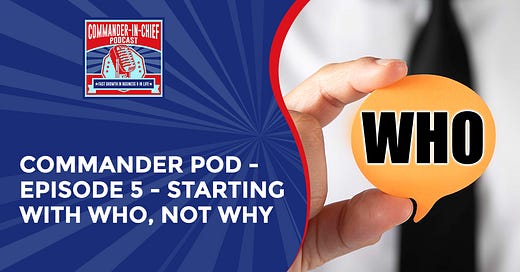



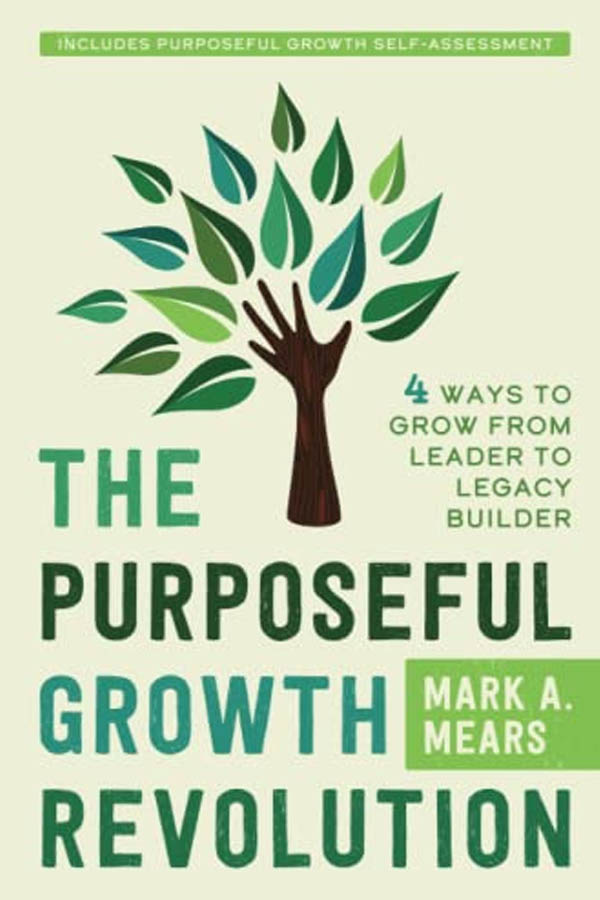
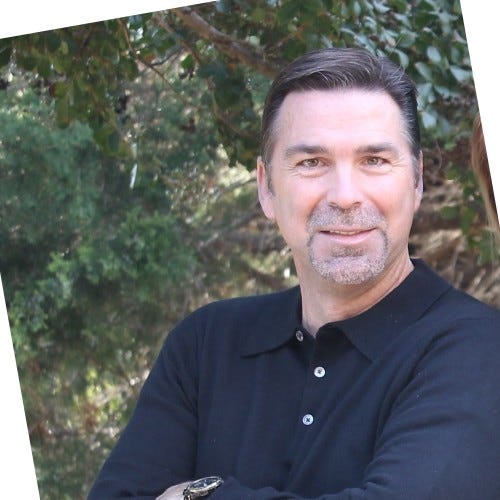

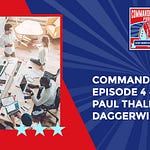
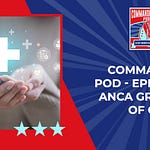
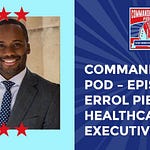



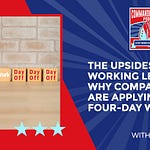
Share this post